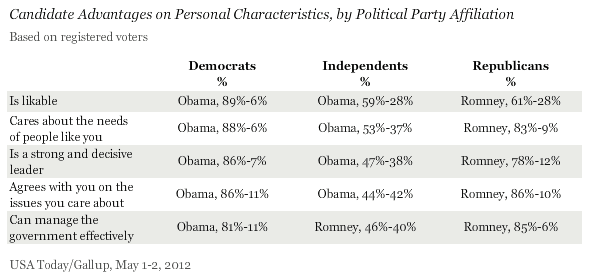PRINCETON, NJ -- Registered voters are nearly twice as likely to say Barack Obama, rather than Mitt Romney, is the more likable of the two presidential candidates. Obama's 60% to 31% advantage on this characteristic is the largest for either candidate on five separate dimensions tested in a May 1-2 USA Today/Gallup poll.
![Next, thinking about the following characteristics and qualities, please say whether you think each one applies more to Barack Obama or more to Mitt Romney. How about -- [RANDOM ORDER]? May 2012 results](http://content.gallup.com/origin/gallupinc/GallupSpaces/Production/Cms/POLL/soopeyyz1kmc23bnt3i2pq.gif)
In fact, Obama leads or statistically ties Romney on each of the five dimensions tested in the poll. He holds a significant lead on caring about the needs of people and being a strong and decisive leader. Romney's best showing is on managing the government effectively, for which he holds a slight but not statistically meaningful 46% to 43% edge over Obama.
As would be expected, Republicans see Romney as the candidate who better exemplifies each of the five positive characteristics, while Democrats choose Obama for all five. Obama's overall advantages are due to his stronger showing among independents, and slightly higher scores among Democrats than Romney receives among Republicans, on most characteristics.

Although Obama has the edge on most characteristics, Romney remains competitive with Obama in terms of vote preference. For the last 10 days, the two have generally been tied or within one percentage point of each other in Gallup Daily tracking of registered voters' candidate preferences.
Still, Romney's large deficit in likability is a potential concern, given that voters usually elect the candidate they like more. In each of the last five presidential elections, the candidate whose basic favorable rating was higher won the election each time. The last time Gallup measured candidate favorable ratings, Obama's favorable rating was much higher than Romney's. The two candidates' Positive Intensity Scores -- another gauge of candidate appeal that takes into account the strength of positive feeling -- are more similar.
Implications
Romney's likability deficit presents a challenge for his campaign as it attempts to shape his image with voters. The campaign can attempt to increase perceptions of Romney as a likable person, or concede that dimension to Obama and try to emphasize other aspects of Romney's character and record on which he is more competitive with Obama, such as perceived managerial competence.
The two are not necessarily mutually exclusive goals; the campaign can certainly attempt to increase Romney's likability, while also emphasizing his other, stronger characteristics in voters' eyes. The question is which strategy is likely to have the greater payoff in terms of increasing Romney's overall support among voters.
At present, Romney doesn't seem to be hurting too badly from a likability deficit, given his competitiveness with Obama in voter support. However, it is also possible Romney would be doing better versus Obama if voters found him more likable.
Survey Methods
Results for this USA Today/Gallup poll are based on telephone interviews conducted May 1-2, 2012, on the Gallup Daily tracking survey, with a random sample of 872 registered voters, aged 18 and older, living in all 50 U.S. states and the District of Columbia.
For results based on the total sample of registered voters, one can say with 95% confidence that the maximum margin of sampling error is ±4 percentage points.
Interviews are conducted with respondents on landline telephones and cellular phones, with interviews conducted in Spanish for respondents who are primarily Spanish-speaking. Each sample includes a minimum quota of 400 cell phone respondents and 600 landline respondents per 1,000 national adults, with additional minimum quotas among landline respondents by region. Landline telephone numbers are chosen at random among listed telephone numbers. Cell phone numbers are selected using random-digit-dial methods. Landline respondents are chosen at random within each household on the basis of which member had the most recent birthday.
Samples are weighted by gender, age, race, Hispanic ethnicity, education, region, adults in the household, and phone status (cell phone only/landline only/both, cell phone mostly, and having an unlisted landline number). Demographic weighting targets are based on the March 2011 Current Population Survey figures for the aged 18 and older non-institutionalized population living in U.S. telephone households. All reported margins of sampling error include the computed design effects for weighting and sample design.
In addition to sampling error, question wording and practical difficulties in conducting surveys can introduce error or bias into the findings of public opinion polls.
View methodology, full question results, and trend data.
For more details on Gallup's polling methodology, visit www.gallup.com.
